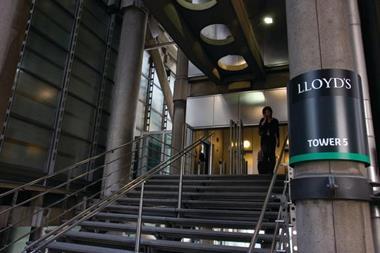The full story of ESR’s dramatic collapse has been revealed in the creditors’ report. James Dean explains.
When things go wrong for a small company, sometimes they can go very wrong indeed. ESR Insurance, a small Lloyd’s broker that fell into administration in February this year, may be liable to pay out £200m in claims – a staggering sum for a company with a turnover of just £2.6m in 2005.
With the publication of the creditors’ report this week, the extent of the fall-out has become clear. It has emerged that administrator Grant Thornton has begun legal proceedings against unnamed parties in the UK, the US and even the Bahamas, while 20 staff have been made redundant and one of the company’s three directors is under investigation for alleged fraud.
The story begins in December 2007, when ESR’s board of directors was alerted to irregularities in the broker’s financial risks division. An internal investigation was launched with the assistance of law firm Clifford Chance. This led to the suspension of director David Bedford, head of ESR’s financial risks division, amid allegations of the invalid issuing of bonds and insurance.
In a letter to ESR’s external partners, director David Taylor said that bonds that were issued by the division were written without authority and likely to be invalid. Staff were asked to hand over details of dealings with the bond division to internal investigators.
The investigation continued for several weeks. The police and FSA stepped into the fray in January, when ESR released a statement suggesting that a US-based party could have been collaborating in the alleged fraud. But finally, late in January this year, the realisation dawned: ESR was unable to pay off crippling debts that had accumulated in its financial risks division.
Emergency funding discussions between ESR directors and parent company Primary Group ensued, but because ESR’s liabilities were too uncertain, Primary decided that paying them off was not viable. In a last-ditch attempt, ESR’s directors tried to sell the firm to a third party, but the negotiations proved fruitless.
“It was imperative that a sale be concluded as soon as possible with the objective of providing security and continuity of service.
Andrew Hosking, Grant Thornton
Following this, ESR approached Grant Thornton for advice on its financial position. Less than two weeks later, on 8 February, the company was put into administration. In a statement, ESR’s directors said the move was the only way forward for the company.
Less than a week after their appointment, administrators from Grant Thornton moved swiftly to sell a collection of ESR’s remaining books of business to Apex Insurance Services, a subsidiary of Lloyd’s broker Crispin Speers, for an estimated £550,000. The deal will also see ESR receive a percentage of the brokerage earned by Apex until February 2010.
Andrew Hosking, joint administrator at Grant Thornton, said: “In order to preserve that business it was imperative that a sale be concluded as soon as possible with the objective of providing security and continuity of service for the company’s clients.”
The deal effectively amounted to the sale of renewal rights to Apex, and the fact that ex-ESR directors Paul Goodman and David Taylor had already made a move to Apex helped clinch the deal. Another 19 of ESR’s old staff joined them at Apex, but 20 ESR staff suddenly found themselves without a job.
In the report to creditors, released this week, Hosking laid bare the extent of the damage to ESR. He noted one particular area of high exposure: a number of clients that dealt with ESR’s financial risks division could claim for the return of premiums paid, as well as damages with respect to policies improperly or invalidly placed. “Based on information available to date, the administrators consider that total claims against the company could, in a worst case scenario, total around £200m,” is his bleak viewpoint.
Such a scenario would only arise if claims were made against ESR in situations where all policies of insurance or bonds fail to respond to claims by insured or bondholders. “Statistically, this scenario is unlikely and the actual quantum of claims against the company is likely to be significantly less”, Hosking adds. Nevertheless, he has been forced to alert the insurers of ESR’s directors’ and officers’ and errors and omissions policies.
“The administrators consider that total claims against the company could, in a worst case scenario, total around 200m GBP.
Administrators report
Because ESR’s exposure to these losses is so difficult to determine, creditors will be forced to play a waiting game. “Given the uncertainty which surrounds the quantum of creditor claims against the company, it is not possible to estimate what return may be available to creditors,” Hosking says, adding that further information should be available in the administrator’s progress report to creditors, due at the start of September.
Wary of ongoing legal action, Hosking declined to address in detail the status of the fraud investigations. “These proceedings and the investigations which underpin them are highly sensitive in nature and the provision of detailed information in this, a public document, is likely to be detrimental to the efforts of the administrators to recover funds for the benefit of creditors,” he says.
All that is known is that the administrators are investigating the recovery of misappropriated funds from a number of parties in the UK, US and the Bahamas. Even so, it seems incredible that the actions of a single department of a small Lloyd’s broker could have stirred up such a huge investigation.
Hosking estimates the continued winding down process will take up to 18 months. Grant Thornton has employed two law firms and a specialist insurance consultant to assist with sales and valuations.
Vodafone, Jet2 and Bank of Scotland are all listed as known creditors, as are a number of brokers. These creditors, as distinct from the parties wishing to claim against ESR’s financial risks division, are estimated to be owed £57,000 – a drop in the ocean compared to the £200m worse case estimate. The administrator is also due £100,000 in fees. As it currently stands, ESR is estimated to have up to £1.5m in assets, but anywhere between £128,000 and £200m plus in liabilities. A meeting of creditors is being held next Friday at Grant Thornton’s London offices.
The ESR saga is far from over – as acknowledged by the administrators. There may be further legal action, while investigations into criminal activities remain in their early stages. The involvement of the FSA and the police in these investigations is a clear indicator of the seriousness of the allegations. So, with the prospect of legal battles on multiple fronts and continuing fraud investigations at home and abroad, ESR provides a frightening lesson on how a business can fall apart in just a few weeks.
Fact file
Worst case scenario: claims totalling 200m GBP.
Administrators have commenced legal proceedings against parties in the UK, US and Bahamas.
20 out of 44 ESR staff made redundant.
ESR director under investigation for alleged fraud.

































